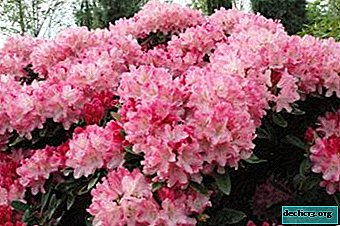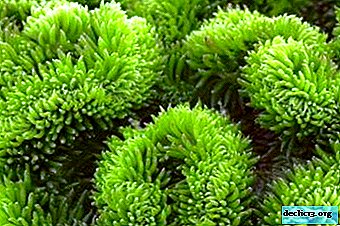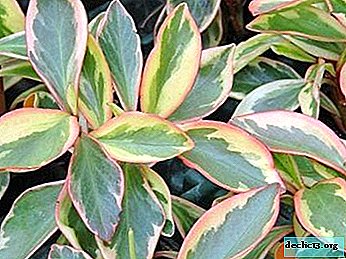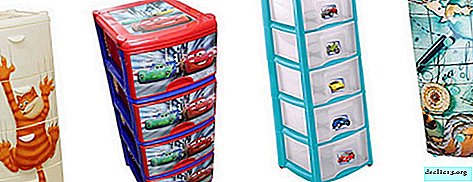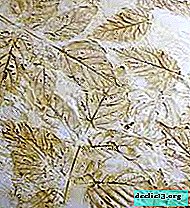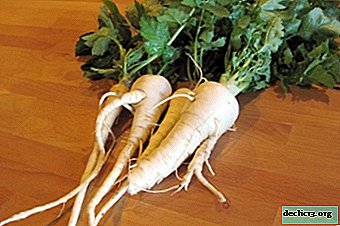Useful home decoration - fragrant pelargonium
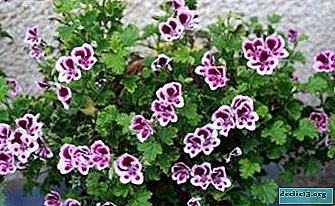
Some lovers of indoor flowers confuse the names of fragrant pelargonium and fragrant geranium and call geranium pelargonium. Before the classification of Karl Linnaeus, there was much debate about how to correctly name these two plants and whether they can be considered related. In fact, thanks to the great scientist, yes: it is established that both belong to the geranium family.
There is a certain similarity of pistils, leaves, stems, features of care and maintenance, and even the type of aroma of these plants. But at the same time, crossbreeding between them is impossible for a number of reasons. In this article we will talk about the features of fragrant pelargonium.
Botanical description, history, price
Pelargonium was brought to Europe from South Africa by the first merchants from the Old World, touched by its lush flowering and unusual pacifying aroma. The plant was able to adapt to the climate in which it found itself, and some species even adapted to life in the open ground in a very cool Russian climate.
The botanical name of the flower is Pelargonium graveolens. This is a perennial herb or shrub plant with a developed root system. The stems are branched, straight or creeping. The leaves are palm-lobed, bright green, covered with villi, which, when touched, exude a unique aroma similar to that of lemon, ginger, pine needles, roses, mint, peach, nutmeg, apple, carrot. The flowers are small, odorless, of various colors, collected in umbrella-shaped inflorescences. Blooms rarely.
ATTENTION: The plant is very widespread, you can buy fragrant pelargonium inexpensively in a flower shop and on street stalls. The price rarely rises above 250 rubles for a rooted small bush.Variety varieties
To date, about 400 species of pelargonium have been bred, while the domestic one has two main varieties:
- Bush - low and magnificent;
- ampelous - with long shoots.
The most popular types of fragrant pelargonium:
- lemon (Mabel Gray) - Pelargonium with lemon aroma of leaves and flowers of pink and purple hues;
- Apple (Apple Cider) - compact pelargonium with very small flowers collected in "umbrellas";
- rose scented (Lady Plymouth) - a plant with light green foliage with a white border and small white flowers;
- with the scent of caramel and rose (Candy Dancer) - her flowers are small, light pink with dark rays or white with lilac;
- with peach and rose aroma (Mons Ninon) - varietal pelargonium of the Unicum class, raspberry-orange flowers with burgundy veins, it feels much better in the garden than in the apartment;
- with mint smell (Pungent Peppermint) - A variety with small pinkish flowers, grown both at home and in the garden;
- spicy or spicy sweet smell (Pink Champagne) - Pelargonium with round leaves and lush pink and scarlet flowers;
- with the smell of wormwood or nutmeg (Fragrans Variegated) - she has small white flowers and soft leaves with a light edging;
- with a resinous mint smell (Filicifolium) - the leaves are very strongly cut, openwork, sticky, small flowers, white with purple rays.
Photo
See below for photos of different types of fragrant pelargonium.





Healing properties
This flower has many useful qualities. Fragrant pelargonium leaves contain:
- organic acids;
- essential oils;
- tannins;
- glycosides;
- gum;
- starch;
- flavonoids;
- pectins;
- volatile;
- resins;
- tannins;
- calcium;
- coumarins;
- saponins.
The ability of fragrant pelargonium to calm the nervous system has long been known. In the house where this magnificent fragrant bush lives, quarrels erupt less often. In the study, pelargonium will help maintain vigor.
Pelargonium leaves have bactericidal, analgesic, antispasmodic, absorbable, decongestant, emollient, immunomodulating, hemostatic and wound healing properties, help with headaches and runny nose. Fragrant pelargonium leaf juice can be used in the treatment of otitis media locally.
Fragrant pelargonium oil is used in the treatment of hypertension, diabetes, infertility, with symptoms of PMS. It is enough to drop a few drops into the aroma lamp and light the candle, either in the bath, or mix 7 g of pelargonium oil and 30 g of base oil and massage.
The smell of fragrant pelargonium has insecticidal properties: it is noticed that if this flower lives on the window, mosquitoes will not dare to enter the room. In the old days, pediculosis was treated with a decoction of pelargonium leaves. Pelargonium twigs in a wardrobe will not let moths.
If you plant a flower in the kitchen, unpleasant odors disappear.
Watch a video about the beneficial properties of fragrant pelargonium:
Contraindications
Contraindications for treatment with drugs from this plant are:
- individual intolerance;
- pregnancy;
- age before 12 and after 70 years;
- stomach ulcer;
- low pressure;
- gastritis.
Where and how to plant?
Fragrant pelargonium - a plant unpretentious and very grateful. It can be grown from a small cuttings or seeds. Pelargonium is tolerant of inappropriate conditions of detention, but still it has its own preferences for care.
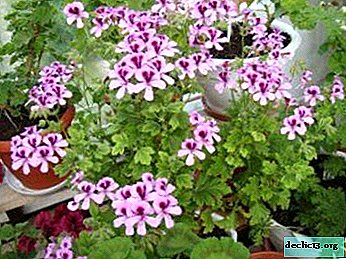 Lighting. The bush, located on a well-lit window, east or west, grows rapidly and blooms lushly. On the south window, a little shading is required, or you can slightly move the plant away from direct rays.
Lighting. The bush, located on a well-lit window, east or west, grows rapidly and blooms lushly. On the south window, a little shading is required, or you can slightly move the plant away from direct rays.- Soil requirements. First, drainage (expanded clay, broken brick or small shards) is placed on the bottom of the pot so that the water does not stagnate and the roots of the pelargonium do not decay. Then put a plant with a lump of earth and add soil mixture for indoor flowers.
The substrate can be prepared independently. To do this, take one part of turf, peat, humus and medium-grained sand. The mixture must be calcined in the oven.
In countries with warm climates, pelargonium grows well in the garden on the brightly lit sunny side. The conditions for watering, pruning and fertilizing for her are the same as for pelargonium at home.
Proper home care
In addition to the basic conditions for the maintenance of pelargonium, there are other important points:
- Air temperature. Pelargonium should not be too hot, it feels good at an air temperature of about + 20 ° C. Airing the room affects it well, and in summer you can safely settle it on the loggia or balcony.
- Watering. You can water the fragrant pelargonium when the earth in the pot dries a little, but you do not need to spray it. The flower is able to accumulate water in the stems and leaves, this property helped the plant survive in the arid climate of South Africa.
- Pot. In a wide pot, the plant directs all forces to the development of the root system, grows slowly, throws out few shoots and hardly blooms. Therefore, it is better to choose a pelargonium pot wider than the root coma for a couple of centimeters.
- Fertilizers. It is not recommended to use fresh organics for top dressing, you need to feed the flower with complex fertilizers with nitrogen, potassium and phosphorus. Fertilizers are applied every two weeks from the end of February to October, in the winter feeding pelargonium is not required.TIP: It is also worth refraining from fertilizing if you have recently replanted this flower. You must wait a month to adapt the plant.
- Pruning and pinching. To give the plant a beautiful, neat appearance and increase the number of shoots, you can pinch old stems, otherwise the flower will stretch out a lot.
Common Diseases and Pests
The main mistakes of flower growers when caring for this flower:
- excessive or vice versa poor watering;
- low light
- cramped or too wide pot;
- use of street land without cultivation.
Most often, pelargonium is affected by fungal diseases caused by dampness: black or gray rot, and the plant can also suffer from pests.
 Black rot of the stem, or black leg. The stalk of pelargonium blackens at the base, and then the infection spreads throughout the plant. The disease is not treated, it can only be prevented by observing safety measures when buying, planting and transplanting a plant.
Black rot of the stem, or black leg. The stalk of pelargonium blackens at the base, and then the infection spreads throughout the plant. The disease is not treated, it can only be prevented by observing safety measures when buying, planting and transplanting a plant.- Gray rot. A gray coating appears on the leaves - this is the first symptom after which it is recommended to take the following measures: stop watering the plant, remove all infected leaves and spray the flower with a fungicidal preparation solution.
- Aphids and Whiteflies. Insects hide on the underside of the leaves and feed on the sap of the plant. Pelargonium leaves turn yellow and fall. After examination, pelargonium must be washed in a soapy solution and treated with insecticides several times.
Propagation Features
This plant propagates by seeds and cuttings. The first method is more difficult, but it gives plants that are more compact, larger and more abundant in bloom.
Seeds
Seeds must be freed from the hard shell, treated with epin and soaked for three hours in water. You need to sow seeds at a distance of about 5 cm from each other, crushing a little into the soil and slightly sprinkling with earth, the layer of which should be no more than 5 mm. After planting the seeds, the earth is watered and the container is covered with glass or film. Keep the container in a well-lit room with an air temperature of about 20 ° C. Shoots appear in two weeks, after which a pick is done, and then transplantation of young plants into separate pots.
Watch the video about planting pelargonium seeds:
Cuttings
Propagation of pelargonium by cuttings does not require special knowledge and effort. From the top of a healthy plant, an shoot with 4-5 leaves is cut off and put into water. Roots appear after a few days, and the plant is ready for planting in a separate pot. The first time you have to keep it in a shaded place and regularly moisten the soil.
Watch the video on the propagation of pelargonium by cuttings:
Conclusion
Fragrant pelargonium is a real decoration of the house and its talisman, creating a comfortable and relaxing atmosphere. Even a beginner grower can cope with the care of fragrant pelargonium. In response, the plant will give its owner a soothing aroma and exquisite flowering.

 Lighting. The bush, located on a well-lit window, east or west, grows rapidly and blooms lushly. On the south window, a little shading is required, or you can slightly move the plant away from direct rays.
Lighting. The bush, located on a well-lit window, east or west, grows rapidly and blooms lushly. On the south window, a little shading is required, or you can slightly move the plant away from direct rays. Black rot of the stem, or black leg. The stalk of pelargonium blackens at the base, and then the infection spreads throughout the plant. The disease is not treated, it can only be prevented by observing safety measures when buying, planting and transplanting a plant.
Black rot of the stem, or black leg. The stalk of pelargonium blackens at the base, and then the infection spreads throughout the plant. The disease is not treated, it can only be prevented by observing safety measures when buying, planting and transplanting a plant.
